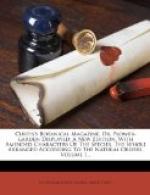He does not mean, however, to confine himself solely to the Plants contained in the highly esteemed works of those luminaries of Botany and Gardening, but shall occasionally introduce new ones, as they may flower in his own garden, or those of the curious in any part of Great-Britain.
At the commencement of this publication, he had no design of entering on the province of the Florist, by giving figures of double or improved Flowers, which sometimes owe their origin to culture, more frequently to the sportings of nature; but the earnest entreaties of many of his Subscribers, have induced him so far to deviate from his original intention, as to promise them one, at least, of the Flowers most esteemed by Florists.
The encouragement given to this work, great beyond the Author’s warmest expectations, demands his most grateful acknowledgements, and will excite him to persevere in his humble endeavours to render Botany a lasting source of rational amusement; and public utility.
Botanic garden,
Lambeth-Marsh,
1787.
[1]
Iris Persica. Persian Iris.
Class and Order.
Triandria Monogynia.
Generic Character.
Corolla 6-partita: Petalis alternis, reflexis. Stigmata petaliformia.
Specific Character and Synonyms.
Iris Persica corolla imberbi, petalis interioribus brevissimis patentissimis. Linn. Syst. Vegetab. p. 79. Sp. Pl. p. 59.
Iris bulbosa praecox minus odora Persica variegata. Moris. hist. 2. p. 357.
XIPHIUM Persicum. Miller Dict. ed. 6. 4_to._
The Persian bulbous Flower-de-luce. Parkins. Parad. p. 172.
[Illustration: No 1]
A native of Persia. Flowers in February and March. Its beauty, early appearance, and fragrant blossoms, make it highly esteemed by all lovers of flowers; like the Hyacinth or Narcissus it will blow within doors in a water-glass, but stronger in a small pot of sand, or sandy loam; a few flowers will scent a whole apartment: it will also blossom in the open air, but requires warmth and shelter; it is propagated by offsets and seeds; the best flowering roots are imported from Holland, they bear forcing well; and hence this plant may be had to flower a full month or six weeks in succession.
PARKINSON remarks, that in his time (1629) it was very rare, and seldom bore flowers.
[2]
Rudbeckia purpurea. Purple Rudbeckia.
Class and Order.
Syngenesia Polygamia Frustranea.
Generic Character.
Receptaculum paleaceum, conicum. Pappus margine quadri-dentato. Calyx duplici ordine squamarum.
Specific Character and Synonyms.
RUDBECKIA purpurea foliis lanceolato-ovatis alternis indivisis, radii petalis bifidis. Linn. Syst. Vegetab. p. 651. Sp. Pl. p. 1280.




